If you have concerns about crib chewing with your baby, this post is for you! It’s all about why a baby might chew on the crib, and how to prevent it.
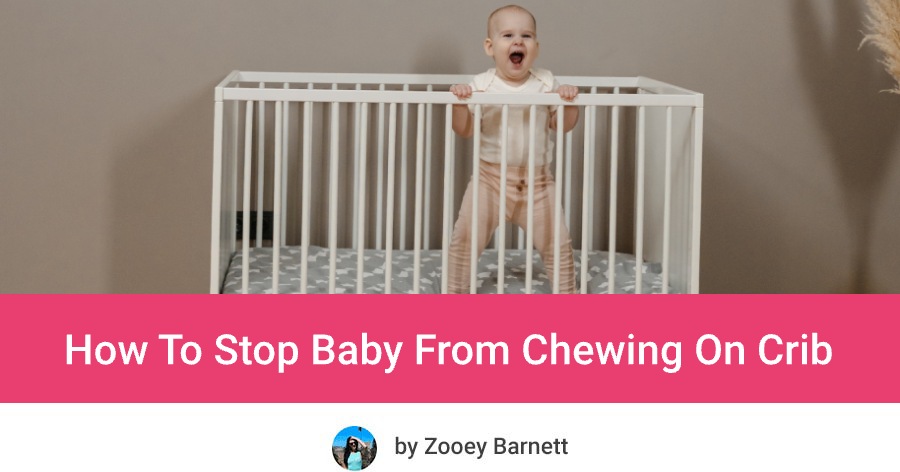
From early in a child’s life, babies interact with the world through their mouths: they use a bottle or breastfeed, they suck on Mama’s fingers, or baby chews a toy to discover its shape.
Now, when a baby starts cutting their first teeth, parents are likely to see babies chewing on almost everything in reach – including their crib railing.
This article is not a substitute for medical advice.
Baby Eating Paint Off Crib?
Now, the first concern is usually around paint: if your crib has been painted or stained, you may be wondering about safety risks and if your baby potentially ingesting toxic paint chips as baby’s teeth make little marks in their crib rail.
In most cases, new cribs follow strict safety standards set by the US government: non toxic paints and dangerous chemicals are to be used with baby products.
What you should pay attention to is if you have purchased a used crib or were gifted a hand-me-down crib. In these cases, you cannot be sure if the previous owner did not paint or stain the crib in their garage before passing it off to you.
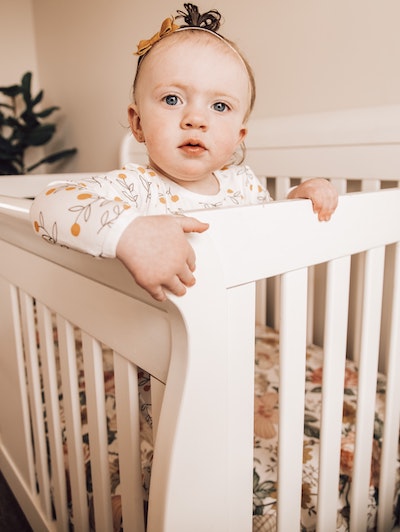
Older cribs (I’m talking vintage here) might be really cute, but the risk of accidentally exposing your baby to harmful toxins with 30+ year old baby furniture just isn’t worth it.
Therefore, only use a new crib with your baby, the extra cost is worth it for your peace of mind.
Why Do Babies Chew On Their Cribs?
If you find your baby chewing on crib rails, know that it is petty common behavior in kids from 8 months old and up. There are there are two main reasons for a baby chewing on crib railings: the first is teething and the second is exploring their senses.
Teething
As mentioned earlier, teething is the primary reason for crib chewing.
Teething discomfort is real for babies. Getting the first set of teeth makes baby’s gums swollen, itchy or even downright painful! So, it makes sense that they will try to chew on literally anything to help feel better.
Babies chewing on various items is an attempt to get relief for their sore gums. You may see babies noshing on teething toys, the corners of board books, or even chewing on their crib railings.
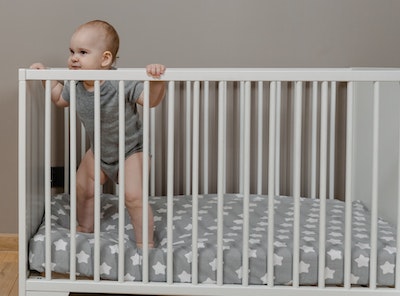
Keep in mind
It is normal for babies to chew on things as they go through the teething phase. You might find little teeth marks all over their toys and other items of furniture within their reach.
Some parents think babies end up sick because of teething, and this isn’t really accurate. It’s a common question parents asked doctors, and the answer is usually that baby chews on dirty items and therefore are exposed to more germs. It’s simply their immune system reacting to an increase of germs from chewing on things, not from the discomfort of teething, itself.
The concern for us, on this post, is if your baby chews on items that have harmful chemicals, like lead paint or wood stains used on furniture items and baby’s crib.
Raw wood poses a risk, as well, because they could get small wood splinters in their mouth.
While you can likely baby-proof your living room and protect your coffee table from baby’s chewing, their crib is another story.
Sensory Exploration
Another common reason for baby chewing on crib rails is because of sensory exploration.
Adults generally use their hands and fingers to learn about objects around them, but most babies engage with the world around them with their mouth during the first year of their life.
![]()
If sensory exploration is the reason your baby is chewing on the crib or mini crib, you will notice them exploring most of the world around them in the same way. You’ll probably see your baby chew on their stroller bars or their soft toys, as well.
Why Is My Toddler Chewing On Crib?
There’s a difference between teething babies versus chewing toddlers.
Now, when your child is around 2 years old, they should have passed the worst teething phase and should hopefully have stopped chewing on anything and everything. They may occasionally put something in their mouth, but it should happen much less.
If, at 2-3 years old, your child is still chewing on things, you might want to consider if they are attempting to get some sort of stimulation. Some children require more physical stimulation than others, or may even be a sign of a sensory processing disorder. If so, being under stimulated could be a reason for chewing on items.
Another possible cause is from anxiety. Similar to adults who might chew their fingernails as a coping mechanism to deal with anxious feelings, children may chew on things to get out uncomfortable emotions or anxious feelings.
In both cases, you will likely see your child chewing on many items, beyond just crib railings. If crib chewing is the only issue, it’s likely not connected to sensory processing needs or anxious feelings.
If you have concerns, please talk to your doctor.
Is Baby Crib Paint Toxic?
Parents may be concerned if their baby’s full size crib or mini crib is safe or if they should avoid wooden cribs which are painted.
Generally, the paint used on your baby’s crib is non toxic and safe, as long as you purchase a new crib from a company that is transparent about their health and safety standards.
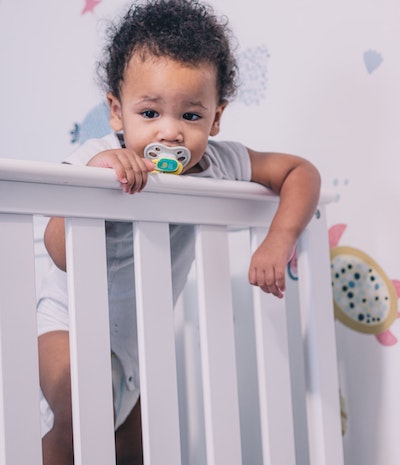
Lead Paint Banned
Back in 1978, the US government banned the use of lead paint because of the adverse health affects found linked to exposure and ingestion.
Does Crib Paint Have Lead?
Nowadays, paint is may be tested for lead and only trace amounts (less than 0.009%), which is too small to be dangerous, is permitted in goods sold in the USA.
However, occasionally, there are instances where furniture items are found to be coated with paint that contain small amounts of lead in excess of US standards, still tiny, but more than the allowed limits. In these circumstances, items are recalled and consumers are asked to stop using and return the items.
Safety Certifications
To avoid a nasty surprise and any risk in exposing your child to harmful toxins, only purchase new cribs from companies that have excellent safety standards.
Greenguard Gold Certification, found with Dream on Me Cribs, DaVinci Baby and other quality baby products meets or exceeds US safety standards. For example, in order to receive a Greenguard Gold Certification, products must be coated with paint that contains less than 0.0001% lead, while the US safety standard only requires 0.0009%.
How To Stop Baby From Chewing On Crib Rails
Here are some ideas and parenting hacks for stopping crib chewing behaviors. The best is prevention.
Prevention methods keep your child from chewing on the crib by limiting their access to the crib rail itself, usually by covering it up.
Silicone Guards
My favorite prevention technique is simple, effective and safe: silicone rail guards. Simply attach silicone guards over your crib rails to prevent baby from chewing on the actual crib. The silicone is usually soft, and perfectly safe for your child to chew on, but will prevent them from getting wood splinters in their mouth, or from actually engaging with the wood stain.
Fabric Crib Rail Cover
You could also use a simple crib rail cover that covers the top railing so that your child chews on the fabric, not the actual wood railing. You can either purchase or easily make your own crib rail covers to prevent your baby from chewing on the crib.
It’s a practical and simple option, but you may find you need to regularly wash these fabric covers, as they easily get covered in baby’s saliva (yuck!).
Two things to note, for either purchasing or making your own fabric rail cover:
1) Use only narrow strips of fabric to cover the upper rail, not to block the vertical slats of your crib.
The main reason is to keep your baby safe: the narrow strip of fabric does not pose a safety hazard if your baby manages to undo the knots used to secure it to the crib.
If you buy or make a wide cover, it could be a suffocation hazard if your baby unties it and accidentally drapes if over themselves.
Another reason is that it does not block the view of your sleeping baby, you can still see them through the slats of the crib.
2) Make sure to use a cover with enough ties to properly secure it onto the crib, and always secure the knots firmly from the outside of the crib. This way, your baby will have a very tough time reaching and untying the rail cover.
Lower The Mattress
A baby cannot chew on the crib if they cannot reach it. This simple prevention method is to simply lower your baby’s crib mattress so they cannot reach the top rail with their teeth.
While it seems like an effective solution, it can be annoying to lower a sleeping baby into a bed that is nearly on the floor.
Offer Alternatives – Teething Toys
Another option is to offer plenty of teething toys so your kids have an alternative to their wooden crib railing.
Babies chew on lots of different things as their first teeth cut through their gums, so give them lots of teethers and soothing textures to help them with their sore gums.
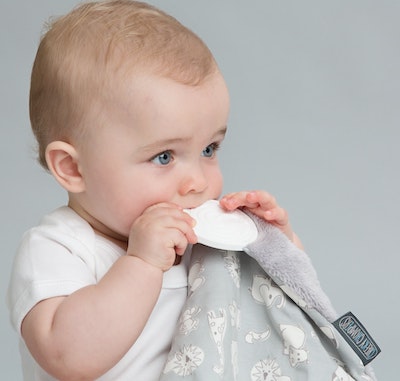
How Do I Stop My Toddler From Chewing On His Crib?
Now, you may be concerned not with a young baby, but with your toddler biting the crib rails.
If your kid is older, first consider if they are ready to go to a “big kid” bed or a toddler bed and move out of the crib entirely.
If they are chewing on other wooden items and you want to protect furniture, consider a reward chart. Make sure to place it in a location they can clearly see from their crib or bed, and use it as a gentle reminder as soon as they wake up to not chew on their crib rail.
Reward charts will work with toddlers who are three years old and up. Start with a short timeframe (one or two days, at first) and allow them to choose the prize – either a special food treat, or an activity which they choose (like going to their favorite play park).
Are Teething Toys Helpful For Stopping Baby From Chewing On Crib?
Yes, teething toys are helpful to encourage baby to chew on something other than crib rails.
However, try to have a variety of different teethers, not just one or two toys.
Giving your baby lots of options with different textures is important for helping them either receive that comfort for their swollen gums. You don’t have to go out and buy a whole lot of teethers, though.
Some at-home items that word great include: a damp toothbrush, frozen treats (or just a clean, frozen wash cloth), a big wooden spoon, or clean toys that come in different shapes and textures, like toy hammers, rag dolls or wooden teething rings.
Just make sure that all toys are large and cannot fit entirely inside your baby’s mouth.
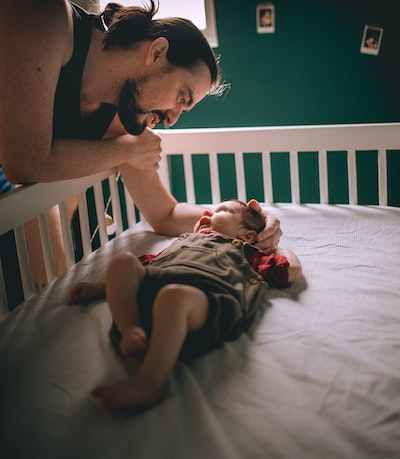
Are Crib Teething Guards Safe?
I prefer the silicone guards that go on crib rails, because they don’t pose any hazard to my baby.
The fabric crib rail covers are not my favorite because, unless you knot them very well, they are easy for a baby to untie and then the cover could potentially drop on them, posing a safety risk if it is too wide.
They are in the same category as crib bumpers; while you might be able to use them with older babies (1 year and up), it’s not advised to use with children less than a year old.
How Do You Get Rid Of Bite Marks On A Crib?
Here are some DIY ideas for removing bike marks from wooden cribs.
Sand It
The easiest way to get bite marks off of your crib rail is to sand it down to make it smooth again. If your rail has a paint or a wood stain on it, you will need to re-paint it or re-stain it to match.
It likely won’t be perfect, but if it’s just for your own aesthetic purposes, it should do the trick.
Walnuts
I know this sounds a bit crazy, but if your crib is real wood – this works! Simply crack open an uncooked, raw walnut and rub it against the bite marks.
This only works with shallow teeth marks, however, not with deep indents.
The purpose of this article is informative. It’s not a substitute for professional medical advice or medical care. Remember: safety first! Consult your doctor/pediatrician in case of any doubts. The author of this article does not accept any responsibility for any liability, loss or risk, personal or otherwise, incurred as a consequence, directly or indirectly, from any information or advice contained here.

